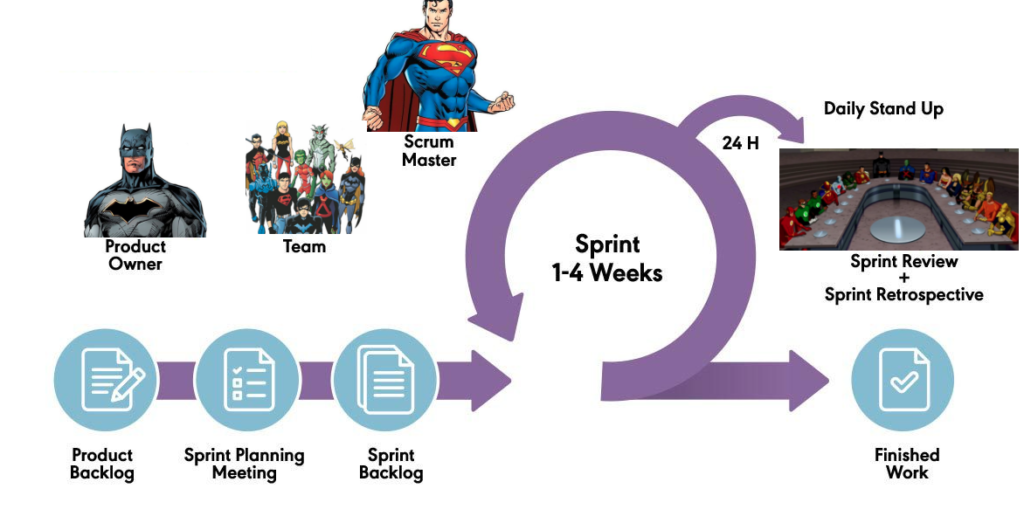In the realm of software development, agile methodologies have revolutionized how projects are managed and delivered. Instead of following rigid and linear processes, the agile method adopts a flexible and iterative approach – almost as if the team moves with the agility of a deer or the cunning of a fox!
What Are Agile Methodologies?
Agile methodologies are not just a set of techniques but a mindset that prioritizes rapid delivery of features, collaboration with the client, and adaptability to change. Rather than investing excessive time in documentation and rigid processes, the focus is on developing functional code that meets real user needs. This approach allows teams to adjust the project’s course in each iteration, ensuring that the final product aligns with stakeholders’ expectations.
Advantages of Agile Approaches
Adopting an agile methodology brings several advantages to software development:
- Short Iterations and Continuous Feedback: In each cycle, or sprint, the team delivers a functional version of the product, allowing constant and quick adjustments based on client feedback.
- Greater Flexibility: In an agile environment, requirement changes can be incorporated naturally without significant impacts on the schedule.
- Active Collaboration: Stakeholder involvement is encouraged, ensuring that the final product truly meets user needs.
- Risk Reduction: By developing incrementally, issues can be identified and resolved earlier, preventing surprises at the end of the project.
- Focus on Quality: Techniques such as Test-Driven Development (TDD) and pair programming help maintain clean code with fewer errors.
Main Agile Approaches
Although the term “agile” encompasses various frameworks and practices, some methodologies stand out in the current landscape:
Scrum
Scrum is one of the most popular agile approaches. Inspired by rugby terminology, Scrum defines short work cycles called sprints (usually two weeks), in which the team meets in daily events – the famous daily stand-ups – to align tasks, discuss impediments, and plan upcoming actions. Key elements of Scrum include:
- Scrum Master: A facilitator who helps the team follow agile practices and removes obstacles.
- Product Owner: Represents the client and is responsible for defining product priorities through the backlog.
- Backlog and Sprints: A list of features and improvements to be implemented throughout the development cycles.

Kanban
Originating from Toyota’s production system, Kanban uses a visual board – either physical with sticky notes or digital – to manage workflow. This method is based on three main columns:
- To Do: Tasks that have not yet started.
- In Progress: Activities under development.
- Done: Completed tasks.
Visualizing the flow allows the team to identify bottlenecks and continuously improve process efficiency.
Extreme Programming (XP)
Extreme Programming (XP) emphasizes code quality and intense collaboration. One of XP’s most well-known practices is pair programming, where two developers work together on the same code, reviewing and adjusting the solution in real time. Additionally, XP promotes writing tests before the code itself, ensuring that development remains focused on delivering simple and functional features.
Rapid Application Development (RAD)
RAD is an approach that values the rapid creation of functional prototypes. The idea is to develop initial versions – or prototypes – that can be tested and evaluated by the client. Based on this feedback, the prototype is refined or even discarded, giving way to a new iteration. This process accelerates delivery and ensures that the final product is always aligned with user expectations.
Integration with DevOps and DevSecOps
As markets become more dynamic, the need to merge development and operations has gained momentum. In this context, DevOps and DevSecOps emerge:
- DevOps: Promotes closer collaboration between development and operations teams, focusing on process automation and continuous delivery.
- DevSecOps: Expands the DevOps concept by integrating security as an essential part of the entire development cycle, ensuring that vulnerabilities are identified and addressed from the beginning.
Scaling Agility: Scaled Agile Framework (SAFe)
For large organizations working with distributed teams and complex projects, the Scaled Agile Framework (SAFe) provides a structure to apply agile principles at scale. SAFe offers different configurations – from essential solutions for smaller teams to approaches that encompass portfolios and entire programs in companies with thousands of employees. This approach helps maintain agility even in complex corporate environments.
Conclusion
Agile methodologies have transformed software development by offering a more flexible, collaborative, and efficient way of working. Whether through Scrum, Kanban, XP, or integrated approaches like DevOps and DevSecOps, the primary focus is always on delivering value quickly and continuously, adapting to changes, and fostering a culture of constant improvement.
Are you interested in applying these methodologies in the real world? In the next post, we will explore how to implement these approaches in an embedded systems project, revealing practical tips and real examples to transform your development process. Stay tuned!



Pingback: Integrated Product Teams: The Secret to Successful Software Development - FortShield: Cybersecurity and Embedded Linux